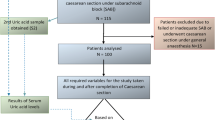Abstract
Methods
We examined the relation between spinal hypotension (systolic blood pressure: <100 mmHg or <80% of the baseline value) and fetoplacental oxygen free radicals during elective cesarean section. Plasma xanthine, serum uric acid and plasma malondialdehyde levels in umbilical venous blood and blood gases in the umbilical artery were measured in patients receiving spinal anesthesia for elective cesarean section complicated with (n=26) and without (n=26) spinal hypotension. Patients with spinal hypotension were divided to two groups on the duration of the hypotension: those with the duration of <2 min (n=19) and those with the duration of ≥2 min (n=7).
Results
There were no measurable differences in these variables between the control and the hypotension with the duration of <2 min groups. While, the plasma xanthine, serum uric acid and plasma malondialdehyde levels in the hypotension group with the duration of ≥2 min were significantly higher than those in the control group without the significant differences in blood gases and pH-levels.
Similar content being viewed by others
References
Boba A, Linkie DM, Plotz EJ (1971) Fetal effects of spinal hypotension: observation in the dog at term of pregnancy. Obstet Gynecol 37:247–252
Cartis SN, Abouleish E, Edelstone DI, Mueller-Heubach E (1980) Fetal acid-base following spinal or epidural anesthesia for Cesarean section. Obstet Gynecol 56:610–615
Chan WS, Irwin MG, Tong WN, Lam YH (1997) Prevention of hypotension during spinal anaesthesia for Cesarean section: ephedrine infusion versus fluid preload. Anaesthesia 52:908–913
Corke BC, Datta S, Ostheimer GW, Weiss JB, Alper MH (1982) Spinal anesthesia for Caesarean section. Anaesthesia 37:658–662
Haruta M, Funato T, Shinkai T (1982) Clinical studies on prevention of spinal hypotension and aortocaval compression during elective cesarean section (in Japanese). Acta Obstet Gynaecol Jpn 34:213–222
Iwama H, Ohmizo H, Furuta S, Ohmori S, Watanabe K, Kanemoto T (2002) Spinal anesthesia hypotension in elective cesarean section in parturients wearing extra-strong compression stocking. Arch Gynecol Obstet 267:85–89
Kelly MC, Fitzpatrick KT, Hill DA (1996) Respiratory effects of spinal anaesthesia for Caesarean section. Anaesthesia 51:1120–1122
Khaw KS, Wang CC, Ngan Kee WD, Pang CP, Rogers MS (2002) Effects of high inspired oxygen fraction during elective cesarean section under spinal anaesthesia on maternal and fetal oxygenation and lipid peroxidation. Br J Anaesth 88:18–23
Kubonoya K, Power GG (1997) Plasma adenosine responses during repeated episodes of umbilical cord occlusion. Am J Obstet Gynecol 177:395–401
Largilliere C, Melancon SB (1988) Free malondialdehyde determination in human plasma by high performance liquid chromatography. Anal Biochem 170:123–126
Marx GF, Cosmi EV, Wollman SB (1969) Biochemical status and clinical condition of mother and infant at Cesarean section. Anesth Analg 48:986–994
McCord JM (1985) Oxygen-derived free radicals in postischemic tissue injury. N Eng J Med 312:159–163
Miller RD (2000) Spinal anesthesia. Anesthesia, vol 1. Churchill Livingstone, Philadelphia, pp 2046–2048
Ratcliffe FM, Evans JM (1993) Neonatal wellbeing after elective caesarean delivery with general, spinal, and epidural anaesthesia. Eur J Anaesthesiol 10:175–181
Roy RS, McCord JM (1983) Superoxide and ischemia: conversion of xanthine dehydrogenase to xanthine oxidase. Greenwald RA, Cohen G (eds) Oxygen radicals and their scavenger system: cellular and medical aspects, vol 2. Elsevier Science, New York, pp 1145–1151
Suzuki S, Yoneyama Y, Sawa R, Murata T, Araki T, Power GG (2000) Changes in fetal plasma adenosine and xanthine concentrations during fetal asphyxia with maternal oxygen administration in ewes. Tohoku J Exp Med 192:275–281
Tercanli S, Schneider M, Visca E, Hösli I, Troeger C, Peukert R, Holzgreve W (2002) Influence of volume preloading on uteroplacental and fetal circulation during spinal anaesthesia for Cesarean section in uncomplicated singleton pregnancies. Fetal Diagn Ther 17:142–146
Wynants J, Van Belle H (1985) Single-run high-performance liquid chromatography of nucleotides, nucleosides, and major purine bases and its application to different tissue extracts. Anal Biochem 144:258–266
Author information
Authors and Affiliations
Corresponding author
Rights and permissions
About this article
Cite this article
Okudaira, S., Suzuki, S. Influence of spinal hypotension on fetal oxidative status during elective cesarean section in uncomplicated pregnancies. Arch Gynecol Obstet 271, 292–295 (2005). https://doi.org/10.1007/s00404-003-0594-6
Received:
Accepted:
Published:
Issue Date:
DOI: https://doi.org/10.1007/s00404-003-0594-6




